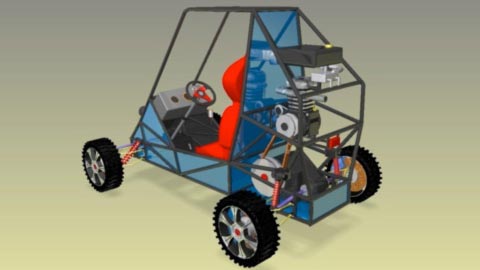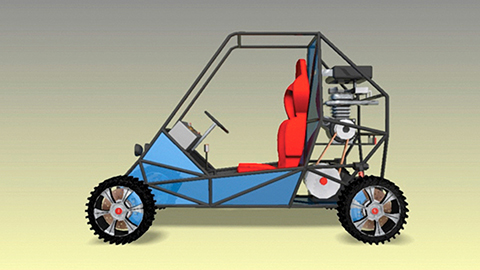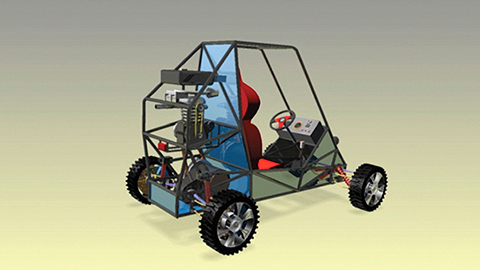PKTEC Students in Real-World PLM Environment
PKTEC Students in Real-World PLM Environment

Students excel using “team design process”
“We were offered educational
packages by other providers,
but we chose NX and Solid Edge,
because we wanted applications
that are widely used and highly
regarded by practicing engineers.”
Prem Prabhath
Director
PKCET
Upgrade to NX and Solid Edge raises PKCET’s profile as a leader among international engineering educational institutions in India
Preparing engineers and technologists for the real world
The Pankajakasthuri College of Engineering & Technology (PKCET) is committed to imparting a value-added education through state-of-the-art facilities and resources that engender customer satisfaction and generate future leaders in the emerging field of engineering. PKCET and Siemens Industry Software (India) Pvt. Ltd. entered into a strategic relationship that has resulted in the establishment of a product lifecycle management (PLM) laboratory on the college campus. With PKCET’s challenging mechanical engineering curriculum and advanced PLM toolset, the college is now firmly established as a leader among international engineering educational institutions in India.

The mission of the Academic Partnership Program from Siemens PLM Software is to improve the technical stature of academic institutions and their ability to develop top-notch PLM engineers and technologists for our communities, customers and business partners. Siemens PLM Software offers all of its partner schools the same world-class product lifecycle management software and services for digital product design, simulation, analysis, manufacturing and product data management (PDM)that are used by Siemens PLM Software’s commercial customers.
Criteria for the new system
The university had been using computer-aided technology (CAx) tools for years, but it was becoming increasingly clear that the school needed to upgrade its CAx tools to keep up with industry standards. In 2011, PKCET finalized its decision to upgrade its computer-aided design (CAD), computer-aided manufacturing (CAM) and computer-aided engineering (CAE) portfolio.
There were three key criteria required of the new system: 1) an integrated PLM environment that would could be easily and quickly learned, 2) the ability to interface with modeling environments already n use, and 3) a toolset that had achieved significant market share so that graduates were learning skills valued by industry. In addition, the software had to be affordable.
The answer was a comprehensive package consisting of NX™ software, Solid Edge® software and support services from Siemens PLM Software and its partner, Shuban Technologies. “Both NX and Solid Edge give us access to synchronous technology,” says Prem Prabhath, director at PKCET. “With synchronous technology, a user no longer has to choose between constraint-driven and history-free model-ing; doesn’t need to be a programmer to re-use a model; and doesn’t have to worry about using data from multiple CAD systems. Use of synchronous technology can yield up to a 100-times faster design process. We were offered educational packages by other providers, but we chose NX and Solid Edge, because we wanted applications that are widely used and highly regarded by practicing engineers.”
Prof. S. Chidambaram, who directs the Department of Mechanical Engineering at PKCET, is also very pleased with the addition of synchronous technology: “We were looking forward to this enhancement for a long time,” says Chidambaran. “Now, when our graduates are ready to apply for skilled manufacturing and engineering positions across industries, they will be proficient in the use of some of the PLM industry’s most advanced software.”
While both NX and Solid Edge provide the unique capabilities of synchronous technology, from a user’s perspective, each offers a compelling collection of other distinct advantages, depending on a firm’s primary requirements.
Prabhath notes that NX provides the industry’s broadest portfolio of integrated, fully associative CAD/CAM/CAE applications. He explains, “Using NX, our students gain knowledge and insight across a comprehensive spectrum of design-through-manufacturing challenges. The students get to experience how all of the elements of product development come together, including part modeling, assembly modeling, surfacing, and CAM. Moreover, NX is very well received by leading companies in India, as it addresses the most rigorous and complex of PLM requirements. So having experience using NX is a real asset when it comes to job placement. And the students like it because navigation is quite intuitive.”
Prabhath is equally impressed with Solid Edge: “It’s a great hybrid 2D/3D system, and even offers a built-in design management tool. I recently led teams of students in the design of a lightweight car for a modeling contest. The flexibility of Solid Edge enabled us to design quickly and design better when compared to other CAD tools.”
Arun Kumar, a student at PKCET who participated on the car project, notes, “We completed the car with just four days of training on the software.”
Prabhath adds, “Even a novice engineer can quickly generate sophisticated designs using Solid Edge. I feel the learning curve for Solid Edge is definitely faster than it is for most other CAD systems.”

The program
The number of students using Siemens PLM Software’s solutions on a daily basis is between approximately 100; a total of around 200 students engage the software over the course of a year. At Level 1, students explore the concepts of wire-frame, surface and solid modeling, drafting and assemblies. At Level 2, they study computer numeric control (CNC) machining and some basic finite element analysis (FEA). Level 3 and masters students develop their FEA skills by working on simulation and advanced simulation projects.
“Students find the design solutions of Siemens PLM Software to be especially user-friendly, so they are not worried about losing any time in acquiring CAD skills, despite the constraints and pressures of a twelve-week semester,” says Prabhath. “Ultimately, we want the students to use high-value tools. We feel that use of NX and Solid Edge provides a unique edge in helping our trainees make smarter engineering decisions faster.”
Prabhath also notes the valuable support of Shuban Technologies: “We receive excellent support from Shuban Technologies, whose experienced engineers are available to quickly address any concerns that may arise. Shuban also manages our software licensing and provides any technical assistance that might be needed on the advanced projects undertaken by seniors and master students.”
The measure of success
Chidambaram concludes, “Our product is the engineer and our graduates are much better engineers when they have acquired skills in CAD/CAM/CAE, especially leading-edge product development solutions such as NX and Solid Edge. If a student gets an industrial placement, a good placement report and an offer of employment after graduation, we believe that we have done our job well. A placement rate of over 90 percent would be good. Our rate is better than that and our graduates find skilled positions virtually immediately.”
Business Challenges
- Equip students with practical skills using cutting-edge CAx technology
- Give students the opportunityto experience real-world engineering projects
- Produce graduates who quickly find employment in skilled engineering and
technology positions
Keys to success
- Solid Edge with synchronous technology
- NX with synchronous technology
- Support by Shuban Technologies
- Quality curriculum offering practical, hands-on know-how
Results
- Increased number of students enrolling and graduating in core mechanical curricula
- Students working in real-world CAD/CAE/CAM environments, gaining valuable software skills, process knowledge and industrial insight
- Student teams designed a lightweight racing car for the Solid Edge Modeling Contest, attracting significant interest from major players in the mechanical industry
Solutions/Services
- NX
www.siemens.com/nx - Solid Edge
www.siemens.com/solidedge
Customers primary business
Engineering and Technology provides a curriculum designed to transform students to professional engineers and technologists. With continuously increasing national eminence and international visibility, the institution provides an acclaimed faculty. PKCET is recognized for providing the academic freedom to pursue cutting-edge technology, a pervasive research culture, an emphasis on the development of individual personality, the importance of a value system, and empowerment at all levels and with a total quality approach.
www.pkcet.ac.in
“ We completed the car with just four days of training on the software.”
Arun Kumar
Engineering student
PKCET
“Our graduates find skilled positions virtually immediately.”
S. Chidambaram
Director
Department of Mechanical Engineering
